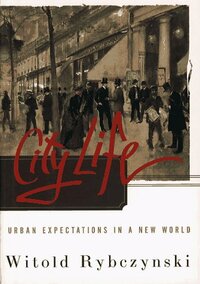Take a photo of a barcode or cover
medium-paced
I liked Rybczynski’s first book “Home” which observed how comfort, family life, privacy, efficiency (damn those Victorians) and work have shaped the idea of home.
“City Life” is an excellent overview of how Americans have evolved the modern culture of cities which remains, I think, one of our few last exports to the rest of the world.
He makes many useful observations:
•The evolving definition of city, or town or burg. The word city comes from towns that had bishopric seats, and had nothing to do with population. In general, it had religious connotations. gulp.
•That Americans simply brought their urban culture to the rural communities. Therefore, it follows that we don’t have the parallel culture like much of Europe but instead in this country share many of the same ideas and attitudes across regions.
So maybe there is hope for us. (More likely, much of what we now share across this nation starts with American Idol and ends with WalMart.)
•That many universities were built by architects as self-contained towns with a rich patron to bankroll the ideas and little or no opposition to their ideas. That made me pause; since almost all architects and planners come from those environs it occurs to me that their last experience of village life before designing new ones are these mock towns that believe wholeheartedly in the built environment and in a sort of medieval spires/gothic fortress view of life.
Uh oh.
But the most important part of this book for me is his chapter on housing for the poor and the great migration (great meaning whole bunches) of African-Americans to the Northern manufacturing areas. As we need to remember, the post war boom was basically over by the mid-1960s and yet no changes were made in the policies of the US for those who had migrated to where the jobs once were. Housing for the poor reflected that missed opportunity and still does.
I wish this part was longer but at least he attempts to add it to the conversation. I agree that accessibility to many things is still the main reason for city life but I am not sure that I agree that with wireless accessibility, fewer physical cities may need to exist. That may be true, although I feel that theory has been preached since the 19th century (and its advent of the ”annihilation of time and distance”) with the invention of the telegraph, railroads and photography, yet cities continued to grow in importance and size in that very time.
I also wish there was more on the immigrant experience and how it has changed in America and therefore changed cities too. I know that in my own city of New Orleans newly arriving immigrants are now moving to the suburbs of Jefferson Parish as soon as they arrive and not to the city center which worries me. I’d like to hear some perspective on that.
Rybczynski writes well for a wide audience and gives concrete examples of places that illustrate his points.
You can do worse than reading this primer, especially if you are new to the subject or like me, if you prefer less academic views of heavy subjects.
I love cities, and I love reading books that try to explain the appeal of cities. What makes a city great, how are the cities of 19th century Europe different from today's modern counterparts? It's all in this short book.
informative
relaxing
slow-paced
City Life provides readers in 2017 (or thereabouts) with two kinds of pleasure. First, there is the pleasure of learning about why cities are the way they are. More specifically, Rybczynski focuses on elucidating why cities are laid out the way they are and how they grew. There are brief allusions to the social character of cities, but maybe not as many as you would expect from a book with the title "City Life." Rybczynski is an architect and a scholar, but he writes like a historian of urban planning. In fact, many of the book's best insights are borrowed from city planners, such as the insight (from planner Kevin Lynch) that cities conform to one of three conceptual models: the "cosmic" (in which the spatial layout of city elements is symbolic, an outgrowth of religious rituals and beliefs), the "practical" (city as machine), and the "organic" (think London or Boston: disorderly, meandering, evolving in an ad-hoc fashion). Rybczynski's historical account focuses primarily on North American cities and their connections to older European cities. It's a whirlwind account, not as thorough as hardcore urban scholars might desire, though he stops to consider a few underappreciated cities like Annapolis and Chicago's short-lived "White City."
The second pleasure comes from how spectacularly wrong Rybczynski is about the future of cities. It's not really his fault. Predicting the future of large-scale human endeavors is a fool's game, though the failed guesses tell you plenty about the time at which they were formulated while reminding you of how quickly things can change. At least Rybczynski wasn't actually designing a city, unlike planner and perennial punching-bag Le Corbusier who, it seems we can all agree, did as much to ruin the urban landscape as anyone.
The book was written in the mid-1990's, a time during which North American urban centers were in steep decline and "white flight" to the suburbs had been happening for so long that it became taken for granted. Rybczynski essentially says that downtowns are not and will not be where city life - that eclectic mix of people, ideas, commerce, and art that define civic existence - resides. He's not so pessimistic as to predict the downfall of civic life as we knew it. This isn't the kind of self-righteous dystopian screed that predicts doom mostly just to give us the pleasure of shaking our fists at someone - corporate fat cats, politicians keen on social engineering, etc. Instead, he says that civic life lives on, and will continue to live on, in shopping malls and suburban sprawl.
I'm all for unorthodox arguments, especially if they help me to appreciate something I'd written off a long time ago. Still, I couldn't help but chuckle and shake my head as Rybczynski praised malls for their orderliness and cleanliness, claiming that they were the most plausible heir to the legacy of Parisian promenades. As I read the book, The New York Times chronicled the utter collapse of the suburban shopping mall while in The Atlantic, Richard Florida lamented the forced exodus of African Americans to rundown suburbs. Reading City Life made me happy Rybczynski was wrong about the ascendance of shopping malls, made me eager to see the next chapter in the development of American cities at a time when we're thinking less about efficiency and more about creating shared space, about reversing gentrification, about increasing bike lanes and affordable housing. Planners, developers, and citizens will try not to repeat the mistakes of the past, though that's no guarantee that they won't make new ones. Still, it's useful to read this book if for no other reason than to renew your faith that America (or at least parts of America) can reverse its course.
The second pleasure comes from how spectacularly wrong Rybczynski is about the future of cities. It's not really his fault. Predicting the future of large-scale human endeavors is a fool's game, though the failed guesses tell you plenty about the time at which they were formulated while reminding you of how quickly things can change. At least Rybczynski wasn't actually designing a city, unlike planner and perennial punching-bag Le Corbusier who, it seems we can all agree, did as much to ruin the urban landscape as anyone.
The book was written in the mid-1990's, a time during which North American urban centers were in steep decline and "white flight" to the suburbs had been happening for so long that it became taken for granted. Rybczynski essentially says that downtowns are not and will not be where city life - that eclectic mix of people, ideas, commerce, and art that define civic existence - resides. He's not so pessimistic as to predict the downfall of civic life as we knew it. This isn't the kind of self-righteous dystopian screed that predicts doom mostly just to give us the pleasure of shaking our fists at someone - corporate fat cats, politicians keen on social engineering, etc. Instead, he says that civic life lives on, and will continue to live on, in shopping malls and suburban sprawl.
I'm all for unorthodox arguments, especially if they help me to appreciate something I'd written off a long time ago. Still, I couldn't help but chuckle and shake my head as Rybczynski praised malls for their orderliness and cleanliness, claiming that they were the most plausible heir to the legacy of Parisian promenades. As I read the book, The New York Times chronicled the utter collapse of the suburban shopping mall while in The Atlantic, Richard Florida lamented the forced exodus of African Americans to rundown suburbs. Reading City Life made me happy Rybczynski was wrong about the ascendance of shopping malls, made me eager to see the next chapter in the development of American cities at a time when we're thinking less about efficiency and more about creating shared space, about reversing gentrification, about increasing bike lanes and affordable housing. Planners, developers, and citizens will try not to repeat the mistakes of the past, though that's no guarantee that they won't make new ones. Still, it's useful to read this book if for no other reason than to renew your faith that America (or at least parts of America) can reverse its course.
1) "...there is something fleeting about the American city, as if it were a temporary venue for diversion, a place to find entertaining novelty, at least for a time, before settling down elsewhere. The historian John Lukacs has written about Americans' recklessness: the tendency to want to move around, not only from one part of the country to another, but from one neighborhood to another, even from one house to another. For such a mobile people, street corners would be appealing. The permanence of residence that was and is the stable foundation of European cities has always been absent in America, and accommodation to this transience has had an effect on the way that cities evolve and are altered. Lukacs speculates that this restlessness may have something to do with the vast, open continent itself."
2) "The original parts of these campuses, where buildings, landscaping, and public plazas complement each other, remain the most fully realized examples of the civic art ideal and probably its most tangible legacy. These academic enclaves, many of which were built from scratch, gave architects the opportunity to design what were in effect small, self-contained towns. With the advantage of a private (and rich) patron and without the constraints imposed by zoning, commercial interests, multiple landowners, and municipal politics, architects could build large, comprehensively planned environments on a scale and with a consistency impossible in the city itself."
3) "Families ate lunch in the food court, a sunny space that almost felt like the outdoors thanks to the fairly large trees and the natural light filtering through the stretched fabric roof. The large open area, which was the convivial focus of the mall, was full of tables and seating; on the periphery were counters whose colorful overhead signs proclaimed a variety of take-away foods: Tex-Mex, Chinese, Italian, Middle Eastern. People carried their trays to the tables. Because there was no physical boundary between the eating area and the surrounding mall, the impression was of a giant sidewalk café.
I suppose that some people would find this an unsophisticated version of urbanity (although you could get a reasonable espresso here), and some of my academic colleagues would refer darkly to 'hyperconsumerism' and artificial reality. But I was more encouraged than depressed by the Plattsburgh mall. I saw people rubbing shoulders and meeting their fellow citizens in a noncombative environment---not behind the wheel of a car, but on foot. As for hyperconsumerism, commercial forces have always formed the center of the American city---the old downtown no less than the new---and it is unclear to me why sitting on a bench in a mall should be considered any more artificial than a bench in the park. Admittedly, I still liked to walk down Margaret Street, but it was a nostalgic urge. When I wanted to be part of a crowd, I went to the mall."
2) "The original parts of these campuses, where buildings, landscaping, and public plazas complement each other, remain the most fully realized examples of the civic art ideal and probably its most tangible legacy. These academic enclaves, many of which were built from scratch, gave architects the opportunity to design what were in effect small, self-contained towns. With the advantage of a private (and rich) patron and without the constraints imposed by zoning, commercial interests, multiple landowners, and municipal politics, architects could build large, comprehensively planned environments on a scale and with a consistency impossible in the city itself."
3) "Families ate lunch in the food court, a sunny space that almost felt like the outdoors thanks to the fairly large trees and the natural light filtering through the stretched fabric roof. The large open area, which was the convivial focus of the mall, was full of tables and seating; on the periphery were counters whose colorful overhead signs proclaimed a variety of take-away foods: Tex-Mex, Chinese, Italian, Middle Eastern. People carried their trays to the tables. Because there was no physical boundary between the eating area and the surrounding mall, the impression was of a giant sidewalk café.
I suppose that some people would find this an unsophisticated version of urbanity (although you could get a reasonable espresso here), and some of my academic colleagues would refer darkly to 'hyperconsumerism' and artificial reality. But I was more encouraged than depressed by the Plattsburgh mall. I saw people rubbing shoulders and meeting their fellow citizens in a noncombative environment---not behind the wheel of a car, but on foot. As for hyperconsumerism, commercial forces have always formed the center of the American city---the old downtown no less than the new---and it is unclear to me why sitting on a bench in a mall should be considered any more artificial than a bench in the park. Admittedly, I still liked to walk down Margaret Street, but it was a nostalgic urge. When I wanted to be part of a crowd, I went to the mall."
Some might think it's outdated because of references to 2000 as the 'future', but the concepts in general I think are applicable even now, in 2012, and beyond.
Very good read. It really put into perspective the American "city", and helps me understand a little better why I have such distaste for American suburbs, rural living and strip malls.
Very good read. It really put into perspective the American "city", and helps me understand a little better why I have such distaste for American suburbs, rural living and strip malls.




